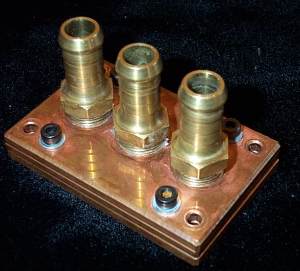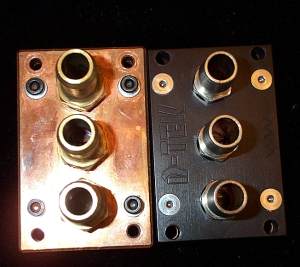|
|
|
|
 Little River Whitewater Review Little River Whitewater Review
|
|
Date Posted: May 6 2004
|
|
Author: pHaestus
|
|
|
|
|
Posting Type: Review
|
|
Category: H2O and High End Cooling Reviews
|
|
Page: 1 of 1
|
|
Article Rank:No Rank Yet
Must Log In to Rank This Article
|
|
|
|
|
Note: This is a legacy article, imported from old code. Due to this some items on the page may not function as expected. Links, Colors, and some images may not be set correctly.
|
|
|
Little River Whitewater Review By: pHaestus
|
|
|
Little River Whitewater Waterblock Review
By: pHaestus 5/06/04
|
|
|
The Little River Whitewater block was an all copper mini-channel waterblock designed by Stew Forster (an Australian water cooling enthusiast). It utilized a rather unique barb configuration (center inlet and two outlets on its ends), a thin baseplate, die area impingement, and 1mm wide channels. The block was so popular that DTek Customs (USA) worked out a deal to produce the Whitewater for substantially lower price to North American customers. There have been some questions as to whether DTek Whitewater blocks have the same performance as the original Little River blocks, however. The objective of this testing was to compare an original Little River Whitewater with its newer, currently available DTek incarnation.
This testing was made possible thanks to nikhsub1 who loaned me the waterblocks for testing. Since these are both ordinary retail blocks (not review samples), they should be representative of average block performance of any end user.
|
|
|
|
The obvious difference in the DTek block is its aluminum top plate and chrome hose barbs. The hose barbs are just cosmetic, of course. Another
difference in the blocks is that their dimensions are slightly different, with the original Little River whitewater being slightly longer and thinner. Finally, when the blocks are placed side by side one can see that the
bottom baseplate piece is thinner on the Little River Whitewater than on the DTek block.
|
|
Test Results and Observations
|
|
Testing methods are the same as used in earlier waterblock reviews. One new development is the estimation that my
TBredB 1700+ at 13x175fsb and 1.85V (BIOS) generates approximately 73W under load. I am hesitant to convert the graphs from deltaT to C/W as of yet (still playing with this sort of W estimation), but that should give you a ballpark number for CPU power. Rather than use the included springs from Little River or Dtek Customs, I used the same mounting
hardware used in all previous "4 Hole mounting" waterblock tests.
The first test I conduct is the variation of waterblock performance over many mounting replicates at 1.50GPM flow
rate.
|
|
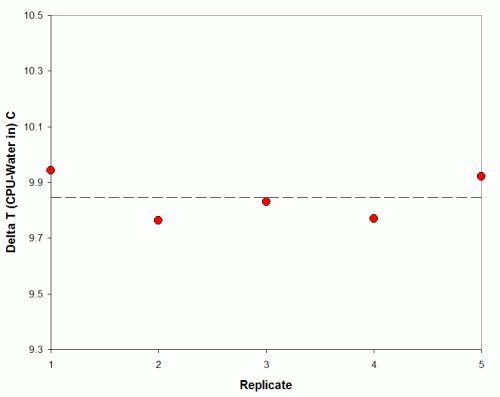 |
|
The dashed line is the average value from the runs. I only mounted the Little River Whitewater 5 times because the standard deviation from those
mounts (0.12 C) was excellent. Since my Maze4 and MCW5000-A testing also showed a decrease in standard deviation, I conclude that my thermal paste application methods must be slowly improving.
The next test conducted is the relationship between waterblock performance and flow rate. To get to the point, I am going to include performance curves
for the previously tested DTek Whitewater as well:
|
|
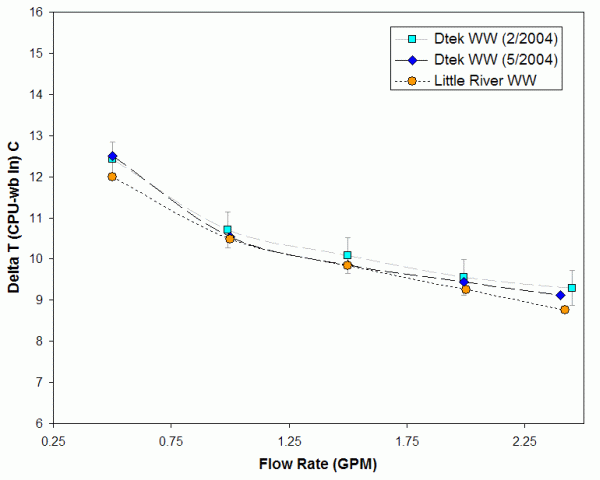 |
|
I reran the DTek Whitewater again to verify that my earlier test results were reproducible. You can see that the new data (blue diamonds) does
indeed fall almost perfectly upon the data from February's testing. That's certainly good! The bottom line is that these blocks perform very similarly, as you'd expect since they share the same design. The
performance of the Little River only falls outside the error bars from previous DTek whitewater testing at 0.5 and 2.5 GPM. I believe that the Little River block performs better at extremely low flow rate because of its
copper top plate. We already know that C/W of the waterblock improves as flow rate increases. This should make the top plate's role in waterblock performance become smaller as flow increases. That is, in fact,
exactly what is observed in these blocks. It would also be interesting to test DTek's poly top Whitewater.
Of more interest, perhaps, is the high flow rate performance. If you look at the shape of the curve between 1 and 2.5 GPM, it appears that the Little
River block has a slightly steeper slope (increased flow rates benefit it more than the Dtek block). I would guess that the Dtek block has a slightly (fractions of a mm) thicker baseplate than the Little River. I
suspect you might observe similar slight variations if you sampled a large number of DTek blocks from different production batches. It's inevitable that there will be some variation in baseplate thickness in a thin
baseplate block like the Whitewater if costs are to be kept reasonable. The difference could also be attributed to a better finish on the Little River baseplate.
In summary, it appears that the DTek Customs Whitewater performs similarly to the Little River block. There are some very minor performance differences,
but it is really pushing my test system's abilities to quantify them.
Thanks again to Scott for loaning me these waterblocks for testing.
|
|
|
|
| Random Forum Pic |
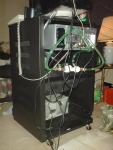 |
| From Thread: New system about to be tested |
|
| | ProCooling Poll: |
| So why the hell not? |
|
I agree!
|
 67% 67%
|
|
What?
|
 17% 17%
|
|
Hell NO!
|
 0% 0%
|
|
Worst Poll Ever.
|
 17% 17%
|
Total Votes:18Please Login to Vote!
|
|






 Little River Whitewater Review
Little River Whitewater Review
